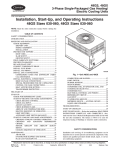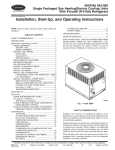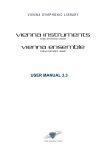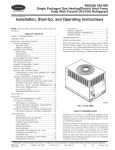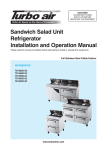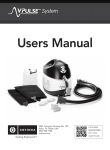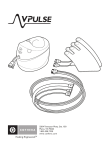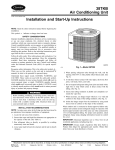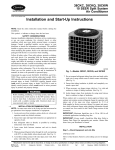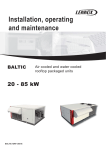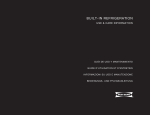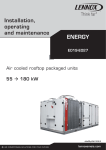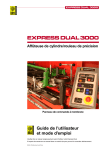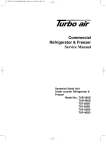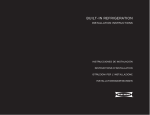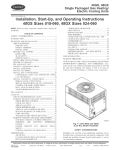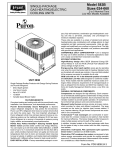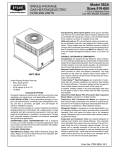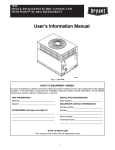Download Installation, Start-Up, and Operating Instructions
Transcript
48SD Single Packaged Gas Heating/ Electric Cooling Units Visit www.carrier.com Installation, Start-Up, and Operating Instructions Size 024-060 NOTE: Read the entire instruction manual before starting the installation. TABLE OF CONTENTS SAFETY CONSIDERATIONS .....................................................1 INTRODUCTION ..........................................................................2 RECEIVING AND INSTALLATION ..........................................2 CHECK EQUIPMENT.............................................................2 IDENTIFY UNIT ................................................................2 INSPECT SHIPMENT ........................................................2 INSTALLATION ................................................................2 PROVIDE UNIT SUPPORT....................................................2 ROOF CURB.......................................................................2 GROUND MOUNT ............................................................4 SLAB MOUNT ...................................................................4 FIELD FABRICATE DUCTWORK........................................6 PROVIDE CLEARANCES ......................................................7 RIG AND PLACE UNIT .........................................................7 CONNECT CONDENSATE DRAIN ......................................7 INSTALL FLUE HOOD ..........................................................8 INSTALL GAS PIPING...........................................................9 INSTALL DUCT CONNECTIONS ......................................10 CONFIGURING UNITS FOR DOWNFLOW (VERTICAL) DISCHARGE ..........................................................10 INSTALL ELECTRICAL CONNECTIONS.........................11 HIGH-VOLTAGE CONNECTIONS................................11 SPECIAL PROCEDURES FOR 208-V OPERATION ...12 CONTROL VOLTAGE CONNECTIONS.......................12 HEAT ANTICIPATOR SETTING...................................12 TRANSFORMER PROTECTION....................................12 PRE-START-UP ..........................................................................12 START-UP ...................................................................................13 CHECK FOR REFRIGERANT LEAKS ...............................13 START-UP HEATING AND MAKE ADJUSTMENTS......15 CHECK HEATING CONTROL.......................................15 CHECK GAS INPUT........................................................15 ADJUST GAS INPUT ......................................................15 CHECK BURNER FLAME..............................................16 AIRFLOW AND TEMPERATURE RISE.......................16 HEATING SEQUENCE OF OPERATION .....................16 LIMIT SWITCHES ...........................................................16 ROLLOUT SWITCH .......................................................16 START-UP COOLING AND MAKE ADJUSTMENTS......17 CHECKING COOLING CONTROL OPERATION .......17 CHECKING AND ADJUSTING REFRIGERANT CHARGE ...........................................................................17 INDOOR AIRFLOW AND AIRFLOW ADJUSTMENTS ..............................................................................17 COOLING SEQUENCE OF OPERATION.....................18 MAINTENANCE.........................................................................18 AIR FILTER......................................................................18 EVAPORATOR BLOWER AND MOTOR.....................18 FLUE GAS PASSAGEWAYS .........................................22 A99338 Fig. 1—Unit 48SD (Low NOx Model Available) COMBUSTION-AIR BLOWER.......................................22 LIMIT SWITCH................................................................22 BURNER IGNITION ........................................................22 MAIN BURNERS .............................................................22 CONDENSER COIL, EVAPORATOR COIL, AND CONDENSATE DRAIN PAN..........................................22 CONDENSER FAN ..........................................................24 ELECTRICAL CONTROLS AND WIRING ..................24 REFRIGERANT CIRCUIT...............................................24 GAS INPUT ......................................................................24 EVAPORATOR AIRFLOW .............................................24 METERING DEVICE — ACCURATER® .....................24 LIQUID LINE STRAINER ..............................................24 TROUBLESHOOTING ...............................................................24 START-UP CHECKLIST............................................................24 NOTE TO INSTALLER — Before the installation, READ THESE INSTRUCTIONS CAREFULLY AND COMPLETELY. Also, make sure the User’s Manual and Replacement Guide are left with the unit after installation. The furnace is NOT to be used for temporary heating of buildings or structures under construction. SAFETY CONSIDERATIONS Installation and servicing of air-conditioning equipment can be hazardous due to system pressure and electrical components. Only trained and qualified personnel should install, repair, or service air-conditioning equipment. Manufacturer reserves the right to discontinue, or change at any time, specifications or designs without notice and without incurring obligations. Book 1 4 PC 101 Printed in U.S.A. Catalog No. 48SD-1SI Pg 1 8-05 Replaces: New Tab 1a 6a shipped from the factory and must be installed in California Air Quality Management Districts or any other regions in North America where a Low NOx rule exists. Untrained personnel can perform basic maintenance functions of cleaning coils and filters. All other operations should be performed by trained service personnel. When working on air-conditioning equipment, observe precautions in the literature, tags, and labels attached to the unit, and other safety precautions that may apply. RECEIVING AND INSTALLATION Follow all safety codes. Wear safety glasses and work gloves. Use quenching cloth for unbrazing operations. Have fire extinguisher available for all brazing operations. Step 1—CHECK EQUIPMENT IDENTIFY UNIT The unit model number and serial number are stamped on unit identification plate. Check this information against shipping papers and job data. Verify unit voltage and amperage requirements listed on unit rating plate agree with power supply provided to unit. FIRE, EXPLOSION, ELECTRICAL SHOCK AND CARBON MONOXIDE POISONING HAZARD Improper installation, adjustment, alteration, service, maintenance, or use can cause carbon monoxide poisoning, fire, or an explosion which can result in personal injury or unit damage. Consult a qualified installer, service agency, or gas supplier for information or assistance. The qualified installer or agency must use only factory-authorized kits or accessories when modifying this product. INSPECT SHIPMENT Inspect for shipping damage while unit is still on shipping pallet. If unit appears to be damaged or is torn loose from its anchorage, have it examined by transportation inspectors before removal. Forward claim papers directly to transportation company. Manufacturer is not responsible for any damage incurred in transit. Check all items against shipping list. Immediately notify the nearest distributor if any item is missing. To prevent loss or damage, leave all parts in original packages until installation. FIRE, EXPLOSION AND ELECTRICAL SHOCK HAZARD Failure to follow this warning could result in personal injury, death and/or property damage. Before performing service or maintenance operations on unit, turn off gas supply to unit. Then turn off unit main power switch and install lockout tag. Electrical shock or explosion could cause serious injury or death. INSTALLATION 1. Remove unit from shipping carton. Leave top shipping skid on the unit as a spreader bar to prevent the rigging straps from damaging the unit. If the wood skid is not available, use a spreader bar of sufficient length to protect unit from damage. 2. Position the lifting bracket assembly around the base of the unit. Be sure the strap does not twist. 3. Place each of the 4 metal lifting brackets into the rigging holds in the composite pan. Recognize safety information. This is the safety-alert symbol . When you see this symbol in instructions or manuals, be alert to the potential for personal injury. 4. Thread lifting bracket strapping around bottom perimeter of unit as follows: Understand the signal words DANGER, WARNING, CAUTION, and NOTE. These words are used with the safety-alert symbol. DANGER identifies the most serious hazards which will result in serious injury or death. WARNING signifies a hazard which could result in serious injury or death. CAUTION is used to identify unsafe practices which may result in minor personal injury or product and property damage. NOTE is used to highlight suggestions which will result in enhanced installation, reliability, or operation. a. Open lever of tension buckle (ratchet type). b. Feed strapping through tension buckle as shown in Fig. 7A. c. Pull strapping through tension buckle unit taut. d. Snap lever down to lock strap in tension buckle. To release strapping, squeeze safety latch, lift lever, and pull webbing outward. 5. Tighten the tension buckle until it is taut. Lifting brackets must be secure in the rigging holds. These instructions cover minimum requirements and conform to existing national standards and safety codes. In some instances, these instructions exceed certain local codes and ordinances, especially those that may not have kept up with changing residential construction practices. We require these instructions as a minimum for a safe installation. 6. Attach field-supplied clevis or hook of sufficient strength to hole in the lifting bracket (See Fig. 7B). 7. Attach the 2 safety straps directly to the clevis or hook at the 4 rigging brackets. DO NOT attach the safety straps to the lifting brackets (See Fig. 7B). 8. Position lifting point directly over the unit’s center of gravity. INTRODUCTION 9. Lift unit. When unit is directly over the roof curb, remove the 2 safety straps. Lower the equipment onto the roof curb. The 48SD unit (See Fig. 1) is fully self-contained, combination Category I gas heating/electric cooling units designed for outdoor installation (See Fig. 2 and 3 for unit dimensions). All unit sizes have return and discharge openings for both horizontal and downflow configurations, and are factory shipped with all downflow duct openings covered. Units may be installed either on a rooftop, a cement slab, or directly on the ground if local codes permit (See Fig. 4 for roof curb dimensions). Step 2—PROVIDE UNIT SUPPORT ROOF CURB Install accessory roof curb in accordance with instructions shipped with curb (See Fig. 4 for roof curb dimensions). Install insulation, cant strips, roofing, and flashing. Ductwork must be attached to curb. Models with an N in the fifth position of the model number are dedicated Low NOxunits designed for California installations. IMPORTANT: The gasketing of the unit to the roof curb is critical for a watertight seal. Install gasketing material supplied with the roof curb. Improperly applied gasketing can also result in air leaks and poor unit performance. These models meet the California maximum oxides of nitrogen (NOx) emissions requirements of 40 nanograms/joule or less as 2 REQUIRED CLEARANCE FOR OPERATION AND SERVICING REQUIRED CLEARANCE TO COMBUSTIBLE MATL. (Refer to Maximum Operating Clearances) INCHES [mm] EVAP. COIL ACCESS SIDE............................................................36.00 [914.0] POWER ENTRY SIDE....................................................................42.00 [1066.8] (EXCEPT FOR NEC REQUIREMENTS) UNIT TOP .......................................................................................48.00 [1219.2] SIDE OPPOSITE DUCTS ..............................................................36.00 [914.0] DUCT PANEL .................................................................................12.00 [304.8] * INCHES [mm] TOP OF UNIT...................................................................................14.00 [355.6] DUCT SIDE OF UNIT.........................................................................2.00 [50.8] SIDE OPPOSITE DUCTS ................................................................14.00 [355.6] BOTTOM OF UNIT .............................................................................0.50 [12.7] NEC. REQUIRED CLEARANCES. *MINIMUM DISTANCES: IF UNIT IS PLACED LESS THAN 12.00 [304.8] FROM WALL SYSTEM, THEN SYSTEM PERFORMANCE MAYBE COMPROMISE. INCHES [mm] BETWEEN UNITS, POWER ENTRY SIDE ....................................42.00 [1066.8] UNIT AND UNGROUNDED SURFACES, POWER ENTRY SIDE .36.00 [914.0] UNIT AND BLOCK OR CONCRETE WALLS AND OTHER GROUNDED SURFACES, POWER ENTRY SIDE.........................42.00 [1066.8] LEGEND CG - Center of Gravity COND - Condensor EVAP - Evaporator NEC - National Electrical Code REQ’D - Required NOTE: Dimensions are in in. [mm] A05166 UNIT WEIGHT UNIT HEIGHT IN. (MM) ″A″ CENTER OF GRAVITY IN. (MM) UNIT ELECTRICAL CHARACTERISTICS lb kg X Y Z 48SD024040/060 208/230-1-60 343.0 156.0 39.02 (991.0) 20.0 (508.0) 19.3 (490.0) 17.6 (447.0) 48SD030040/060 208/230-1-60 366.0 166.0 41.02 (1042.0) 20.0 (508.0) 14.0 (356.0) 13.0 (330.0) Fig. 2—48SD024-030 Unit Dimensions 3 REQUIRED CLEARANCE FOR OPERATION AND SERVICING REQUIRED CLEARANCE TO COMBUSTIBLE MATL. (Refer to Maximum Operating Clearances) INCHES [mm] TOP OF UNIT...................................................................................14.00 [355.6] DUCT SIDE OF UNIT.........................................................................2.00 [50.8] SIDE OPPOSITE DUCTS ................................................................14.00 [355.6] BOTTOM OF UNIT .............................................................................0.50 [12.7] NEC. REQUIRED CLEARANCES. INCHES [mm] BETWEEN UNITS, POWER ENTRY SIDE ....................................42.00 [1066.8] UNIT AND UNGROUNDED SURFACES, POWER ENTRY SIDE .36.00 [914.0] UNIT AND BLOCK OR CONCRETE WALLS AND OTHER GROUNDED SURFACES, POWER ENTRY SIDE.........................42.00 [1066.8] INCHES [mm] EVAP. COIL ACCESS SIDE............................................................36.00 [914.0] POWER ENTRY SIDE....................................................................42.00 [1066.8] (EXCEPT FOR NEC REQUIREMENTS) UNIT TOP .......................................................................................48.00 [1219.2] SIDE OPPOSITE DUCTS ..............................................................36.00 [914.0] DUCT PANEL .................................................................................12.00 [304.8] * *MINIMUM DISTANCES: IF UNIT IS PLACED LESS THAN 12.00 [304.8] FROM WALL SYSTEM, THEN SYSTEM PERFORMANCE MAYBE COMPROMISE. LEGEND CG - Center of Gravity COND - Condensor EVAP - Evaporator NEC - National Electrical Code REQ’D - Required NOTE: Dimensions are in in. [mm] A05142 UNIT WEIGHT UNIT HEIGHT IN. (MM) ″A″ CENTER OF GRAVITY IN. (MM) UNIT ELECTRICAL CHARACTERISTICS lb kg X Y Z 48SD036060/090 208/230-1-60 433.0 196.0 42.98 (1092.0) 21.0 (533.0) 20.5 (520.0) 16.6 (422.0) 48SD042060/090 208/230-1-60 460.0 209.0 46.98 (1193.0) 21.0 (533.0) 20.5 (520.0) 17.1 (434.0) 48SD048090/115/130 208/230-1-60 480.0 218.0 46.98 (1193.0) 21.0 (533.0) 20.0 (508.0) 17.4 (442.0) 48SD060090/115/130 208/230-1-60 492.0 223.0 46.98 (1193.0) 21.0 (533.0) 20.0 (508.0) 17.6 (447.0) Fig. 3—48SD036-060 Unit Dimensions SLAB MOUNT Curb should be level to within 1/4 in. This is necessary for unit drain to function properly. Refer to accessory roof curb installation instructions for additional information as required. Place the unit on a solid, level concrete pad that is a minimum of 4 in. thick with 2 in. above grade. The slab should be flush on the compressor end of the unit (to allow condensate drain installation) and should extend 2 in. on the three remaining sides of the unit (See Fig. 6). Do not secure the unit to the slab except when required by local codes. GROUND MOUNT The unit may be installed either on a slab or placed directly on the ground if local codes permit. Place the unit on level ground prepared with gravel for condensate discharge. 4 HVAC unit base HVAC unit base Screw (NO TE A) Gask eting inner flange* Screw (NOTE A) Gasketing inner flange* *Gasketing outer flange *Gasketing outer flange Wood nailer* Flashing field supplied Wood nailer* Flashing field supplied Roofcurb* Insulation (field supplied) Roofing material field supplied Insulation (field supplied) Roofing material field supplied Duct wo rk field supplied Cant strip field supplied Roofcurb* Duct wo rk field supplied Cant strip field supplied Roof Roof *Provided with roofcurb *Provided with roofcurb Roof Curb for Small Cabinet Roof Curb for Large Cabinet Note A: When unit mounting scre w is used , retainer bracke t must also be used. Note A: When unit mounting scre w is used , retainer bracket must also be used. E G Supply opening (B x C) G B Typ. F F D CTyp. R/A A E Gasket around duct D Insulated deck pan Short Support Insulated deck pan S/A Gasket around outer edge Long Support Return opening (B X C) A05165 A B UNIT SIZE ODS CATALOG NUMBER IN. (MM) IN. (MM) CPRFCURB006A00 8 (203) 11(279) 48SD024-030 CPRFCURB007A00 14 (356) 11(279) CPRFCURB008A00 8 (203) 16 3/16 (411) 48SD036-060 CPRFCURB009A00 14 (356) 16 3/16 (411) C D E IN. (MM) IN. (MM) IN. (MM) 161/2 (419) 28-3/4 (730) 30-3/8 (771) 161/2 (419) 28-3/4 (730) 30-3/8 (771) 17 3/8 (441) 40-1/4 (1022) 41-15/16 (1065) 17 3/8 (441) 40-1/4 (1022) 41-15/16 (1065) F G IN. (MM) IN. (MM) 44-5/16 (1126) 45-15/16 (1167) 44-5/16 (1126) 45-15/16 (1167) 44-7/16 (1129) 46-1/16 (1169) 44-7/16 (1129) 46-1/16 (1169) NOTES: 1. Roof curb must be set up for unit being installed. 2. Seal strip must be applied, as required, to unit being installed. 3. Dimensions in ( ) are in millimeters. 4. Roof curb is made of 16-gage steel. 5. Table lists only the dimensions, per part number, that have changed. 6. Attach ductwork to curb (flanges of duct rest on curb). 7. Insulated panels: 1-in. thick fiberglass 1 lb density. 8. Dimensions are in inches. 9. When unit mounting screw is used (see Note A), a retainer bracket must be used as well. This bracket must also be used when required by code for hurricane or seismic conditions. This bracket is available through Micrometl. Fig. 4—Roof Curb Dimensions 5 1 2 y 4 3 x C00070 CORNER # 1 2 3 4 TOTAL WEIGHT 48SD 024 69 53 83 138 343 030 74 57 88 147 366 036 87 68 104 174 433 042 93 72 111 184 460 048 97 74 116 193 480 060 99 76 119 198 492 Fig. 5—48SD Unit Corner Weights (in Pounds) OPTIONAL RETURN AIR OPENING OPTIONAL SUPPLY AIR OPENING DETAIL A 2" (50.8mm) EVAP. COIL COND. COIL C99015 C99014 Fig. 6—Slab Mounting Details SIZE Step 3—FIELD FABRICATE DUCTWORK 024 030 036 042 048 060 Secure all ducts to roof curb and building structure on vertical discharge units. Do not connect ductwork to unit. For horizontal applications, unit is provided with flanges on the horizontal openings. Installation of flexible duct connector is recommended to prevent transmission of vibration and /or noise to structure. All ductwork should be secured to the flanges. Insulate and weatherproof all external ductwork, joints, and roof openings with counter flashing and mastic in accordance with applicable codes. MAXIMUM WEIGHT A lb kg in. mm UNIT 48SD 372 169 20.0 508.0 395 179 20.0 508.0 462 210 21.0 533.4 489 222 21.0 533.4 509 231 21.0 533.4 521 236 21.0 533.4 B in. mm 19.3 14.0 20.5 20.5 20.0 20.0 490.2 355.6 520.7 520.7 508.0 508.0 Fig. 7—Suggested Rigging Step 4—PROVIDE CLEARANCES Ducts passing through an unconditioned space must be insulated and covered with a vapor barrier. If a plenum return is used on a vertical unit, the return should be ducted through the roof deck to comply with applicable fire codes. A minimum clearance is not required around ductwork. Cabinet return-air static shall not exceed -.25 in. wg. 6 The required minimum operating and service clearances are shown in Fig. 2 and 3. Adequate combustion, ventilation and condenser air must be provided in accordance with section 5.3, Air for Combustion and Ventilation, of the National Fuel Gas Code ANSI (American National Standards Institute) Z223.1 or applicable provisions of local building code. In Canada, follow sections 7.2, Table 1 —Physical Data—Unit 48SD UNIT SIZE 48SD NOMINAL CAPACITY (ton) OPERATING WEIGHT (lb.) COMPRESSORS Quantity REFRIGERANT (R-22) Quantity (lb.) REFRIGERANT METERING DEVICE Orifice ID (in.) CONDENSER COIL Rows...Fins/in. Face Area (sq ft) CONDENSER FAN Nominal Cfm Diameter (in.) Motor Hp (Rpm) EVAPORATOR COIL Rows...Fins/in. Face Area (sq ft) EVAPORATOR BLOWER Nominal Airflow (Cfm) Size (in.) Motor Hp (Rpm) FURNACE SECTION* Burner Orifice No. (Qty...Drill Size) Natural Gas Burner Orifice No. (Qty...Drill Size) Propane Gas RETURN-AIR FILTERS (in.)† Throwaway 024040 2 343 024060 2 343 030040 2½ 366 036090 3 433 042060 3½ 460 042090 3½ 460 7.8 7.8 8.4 8.4 10.9 10.9 10.9 10.9 .065 .065 .070 Accurater .070 .080 .080 .088 .088 2...21 11.9 2...21 11.9 2...21 13.6 2...21 13.6 2...21 15.5 2...21 15.5 2...21 19.4 2...21 19.4 2700 22 1/8 (825) 2700 22 1/8 (825) 2700 22 1/8 (825) 2700 22 1/8 (825) 2800 22 1/8 (825) 2800 22 1/8 (825) 2800 22 1/8 (825) 2800 22 1/8 (825) 3...17 3.7 3...17 3.7 3...17 3.7 3...17 3.7 3...17 4.7 3...17 4.7 3...17 4.7 3...17 4.7 800 10 X 10 1/3 (1050) 800 10 X 10 1/3 (1050) 1000 10 X 10 1/3 (1050) 1000 10 X 10 1/3 (1050) 1200 11 X 10 1/2 (1000) 1200 11 X 10 1/2 (1000) 1400 11 X 10 1/2 (1075) 1400 11 X 10 1/2 (1075) 2...44 2...50 2...38 2...46 2...44 2...50 2...38 2...46 2...38 2...46 3...38 3...46 2...38 2...46 3...38 3...46 20 X 24 X 1 030060 036060 2½ 3 366 433 Scroll 1 24 X 36 X 1 * Based on altitude of 0 to 2000 ft. † Required filter sizes shown are based on the larger of the ARI (Air Conditioning and Refrigeration Institute) rated cooling airflow or the heating airflow velocity of 300 ft/minute for high-capacity type. Air filter pressure drop for non-standard filters must not exceed 0.08 in. wg. Step 5—RIG AND PLACE UNIT 7.3, or 7.4 or Can/CGA. (Canadian Gas Association) B149 Installation Codes or applicable provisions of local building code. PROPERTY DAMAGE HAZARD Failure to follow this caution may result in property damage. When installing the unit on a rooftop, be sure the roof will support the additional weight. OPERATIONAL HAZARD Failure to follow this caution may result in unit component damage. Do not restrict condenser airflow. An air restriction at either the outdoor-air inlet or the fan discharge can be detrimental to compressor life. Use spreader bars or crate top when rigging the unit. The units must be rigged for lifting (See Fig. 7). Refer to Table 1 for operating weight. Use extreme caution to prevent damage when moving the unit. Unit must remain in an upright position during all rigging and moving operations.The unit must be level within 1/4” for proper condensate drainage; therefore, the ground-level pad or accessory roof curb must be level before setting the unit in place. When a field-fabricated support is used, be sure that the support is level and properly supports the unit. Lifting point should be directly over the center of gravity for the unit. The condenser fan pulls air through the condenser coil and discharges it through the top cover. Be sure that the fan discharge does not recirculate to the condenser coil. Do not locate the unit in either a corner or under an overhead obstruction. The minimum clearance under a partial overhang (such as a normal house overhang) is 48-in. above the unit top. The maximum horizontal extension of a partial overhang must not exceed 48-in. Do not place the unit where water, ice, or snow from an overhang or roof will damage or flood the unit. Do not install the unit on carpeting, tile, or other combustible materials. The unit may be installed on wood flooring or on Class A, B, or C roof covering materials. Step 6—CONNECT CONDENSATE DRAIN NOTE: When installing condensate drain connection be sure to comply with local codes and restrictions. Model 48SD disposes of condensate water through a 3/4 in. NPT fitting which exits through the compressor access panel (See Fig. 2 and 3 for location). Condensate water can be drained directly onto the roof in rooftop installations (where permitted) or onto a gravel apron in groundlevel installations. Install a field-supplied condensate trap at end of condensate connection to ensure proper drainage. Make sure that the outlet of the trap is at least 1 in. lower than the drain pan 7 Table 1—Physical Data—Unit 48SD (Continued) UNIT SIZE 48SD NOMINAL CAPACITY (ton) OPERATING WEIGHT (lb.) COMPRESSORS Quantity REFRIGERANT (R-22) Quantity (lb.) 048090 4 480 048130 4 480 060090 5 492 060115 5 492 060130 5 492 12.0 12.0 12.0 Scroll 1 12.3 12.3 12.3 .088 .088 .088 .101 .101 .101 2...21 19.4 2...21 19.4 2...21 19.4 2...21 19.4 2...21 19.4 2...21 19.4 3300 22 ¼ (1100) 3300 22 ¼ (1100) 3300 22 ¼ (1100) 3300 22 ¼ (1100) 3300 22 ¼ (1100) 3300 22 ¼ (1100) 4...15 4.7 4...15 4.7 4...15 4.7 4...15 4.7 4...15 4.7 4...15 4.7 1600 11 X 10 1/2 (1075) 1600 11 X 10 1/2 (1075) 1600 11 X 10 1/2 (1075) 1750 11 X 10 1.0 (1040) 1750 11 X 10 1.0 (1040) 1750 11 X 10 1.0 (1040) 3...38 3...46 3...33 3...42 3...31 3...41 3...38 3...46 3...33 3...42 3...31 3...41 Accurater REFRIGERANT METERING DEVICE Orifice ID (in.) CONDENSER COIL Rows...Fins/in. Face Area (sq ft) CONDENSER FAN Nominal Cfm Diameter (in.) Motor Hp (Rpm) EVAPORATOR COIL Rows...Fins/in. Face Area (sq ft) EVAPORATOR BLOWER Nominal Airflow (Cfm) Size (in.) Motor Hp (Rpm) FURNACE SECTION* Burner Orifice No. (Qty...Drill Size) Natural Gas Burner Orifice No. (Qty...Drill Size) Propane Gas RETURN-AIR FILTERS (in.)† Throwaway 048115 4 480 24 X 36 X 1 * Based on altitude of 0 to 2000 ft. † Required filter sizes shown are based on the larger of the ARI (Air Conditioning and Refrigeration Institute) rated cooling airflow or the heating airflow velocity of 300 ft/minute for high-capacity type. Air filter pressure drop for non-standard filters must not exceed 0.08 in. wg. condensate connection to prevent the pan from overflowing (See Fig. 8). Prime the trap with water. When using a gravel apron, make sure it slopes away from the unit. NOTE: Dedicated low NOx models MUST be installed in California Air Quality Management Districts where a Low NOx rule exists. If the installation requires draining the condensate water away from the unit, install a 2-in. trap at the condensate connection to ensure proper drainage (See Fig. 8). Make sure that the outlet of the trap is at least 1 in. lower than the drainpan condensate connection. This prevents the pan from overflowing. These models meet the California maximum oxides of nitrogen (NOx) emissions requirements of 40 nanograms/joule or less as shipped from the factory. NOTE: Low NOx requirements apply only to natural gas installations. Prime the trap with water. Connect a drain tube – using a minimum of 3/4-in. PVC or 3/4-in. copper pipe (all field-supplied) – at the outlet end of the 2-in. trap. Do not undersize the tube. Pitch the drain tube downward at a slope of at least 1-in. for every 10 ft of horizontal run. Be sure to check the drain tube for leaks. CARBON MONOXIDE POISONING HAZARD Failure to follow this warning could result in personal injury or death. The venting system is designed to ensure proper venting. The flue hood assembly must be installed as indicated in this section of the unit installation instructions. TRAP OUTLET 1" min. Install the flue hood as follows: 1. This installation must conform with local building codes and with the National Fuel Gas Code (NFGC), ANSI Z223.1 (in Canada, CAN/CGA B149.1, and B149.2) or NFPA (National Fire Protection Association) latest revision. Refer to Provincial and local plumbing or wastewater codes and other applicable local codes. 2" min. C00009 2. Remove flue hood from shipping location (inside the blower compartment). Place vent cap assembly over flue panel. Orient screw holes in vent cap with holes in the flue panel. Fig. 8—Condensate Trap Step 7—INSTALL FLUE HOOD 3. Secure flue hood to flue panel by inserting a single screw on the right side and the left side of the hood. The flue assembly is secured and shipped in the return air duct. Remove duct cover to locate the assembly (See Fig. 10A). 8 Table 2—Maximum Gas Flow Capacity* NOMINAL IRON PIPE, SIZE (IN.) 1/2 3/4 1 1-1/4 1-1/2 LENGTH OF PIPE, FT† INTERNAL DIAMETER (IN.) 10 20 30 40 50 60 70 80 90 100 125 150 175 200 .622 .824 1.049 1.380 1.610 175 360 680 1400 2100 120 250 465 950 1460 97 200 375 770 1180 82 170 320 600 990 73 151 285 580 900 66 138 260 530 810 61 125 240 490 750 57 118 220 460 690 53 110 205 430 650 50 103 195 400 620 44 93 175 360 550 40 84 160 325 500 — 77 145 300 460 — 72 135 280 430 * Capacity of pipe in cu ft of gas per hr for gas pressure of 0.5 psig or less. Pressure drop of 0.5-in. wg (based on a 0.60 specific gravity gas). Refer to Table C-4, National Fire Protection Association NFPA 54. † This length includes an ordinary number of fittings. Step 8—INSTALL GAS PIPING pipe sizes larger than 1/2 in., follow recommendations of national codes. The gas supply pipe enters the unit through the access hole provided. The gas connection to the unit is made to the 1/2-in. FPT gas inlet on the manual shutoff or gas valve. 3. Apply joint compound (pipe dope) sparingly and only to male threads of joint when making pipe connections. Use only pipe dope that is resistant to action of liquefied petroleum gases as specified by local and/or national codes. Never use Teflon tape. Install a gas supply line that runs to the heating section. Refer to Table 2 and the NFGC for gas pipe sizing. Do not use cast-iron pipe. It is recommended that a black iron pipe is used. Check the local utility for recommendations concerning existing lines. Size gas supply piping for 0.5 in. wg maximum pressure drop. Never use pipe smaller than the 1/2-in. FPT gas inlet on the unit gas valve. 4. Install sediment trap in riser leading to heating section (See Fig. 9). This drip leg functions as a trap for dirt and condensate. For natural gas applications, the gas pressure at unit gas connection must not be less than 4.0 in. wg or greater than 13 in. wg while the unit is operating. For propane applications, the gas pressure must not be less than 7.0 in. wg or greater than 13 in. wg at the unit connection. IN An 1/8-in. NPT plugged tapping, accessible for test gage connection, must be installed immediately upstream of the gas supply connection to the gas valve. When installing the gas supply line, observe local codes pertaining to gas pipe installations. Refer to the NFGC ANSI Z223.1-1988 NFPA latest edition (in Canada, CAN/CGA B149.1, (2)-M86). In the absence of local building codes, adhere to the following pertinent recommendations: TEE OUT NIPPLE 3˝ MIN CAP 1. Avoid low spots in long runs of pipe. Grade all pipe 1/4 in. in every 15 ft to prevent traps. Grade all horizontal runs downward to risers. Use risers to connect to heating section and to meter. Fig. 9—Sediment Trap 2. Protect all segments of piping system against physical and thermal damage. Support all piping with appropriate straps, hangers, etc. Use a minimum of one hanger every 6 ft. For 5. Install an accessible, external, manual main shutoff valve in gas supply pipe within 6 ft of heating section. C99020 9 6. Install ground-joint union close to heating section between unit manual shutoff and external manual main shut-off valve. 7. Pressure-test all gas piping in accordance with local and national plumbing and gas codes before connecting piping to unit. NOTE: Pressure test the gas supply system after the gas supply piping is connected to the gas valve. The supply piping must be disconnected from the gas valve during the testing of the piping systems when test pressure is in excess of 0.5 psig. Pressure test the gas supply piping system at pressures equal to or less than 0.5 psig. The unit heating section must be isolated from the gas piping system by closing the external main manual shutoff valve and slightly opening the ground-joint union. FIRE OR EXPLOSION HAZARD Failure to follow this warning could result in fire, explosion, personal injury, death and/or property damage. -Connect gas pipe to unit using a backup wrench to avoid damaging gas controls. -Never purge a gas line into a combustion chamber. Never test for gas leaks with an open flame. Use a commercially available soap solution made specifically for the detection of leaks to check all connections. -Use proper length of pipe to avoid stress on gas control manifold. -If a flexible connector is required or allowed by authority having jurisdiction, black iron pipe shall be installed at furnace gas valve and extend a minimum of 2 in. outside furnace casing. -If codes allow a flexible connector, always use a new connector. Do not use a connector which has previously serviced another gas appliance. SUPPLY DUCT OPENING RETURN DUCT OPENING VENT HOOD SHIPPING LOCATION A05143 Fig. 10A Supply and Return Duct Opening 8. Check for gas leaks at the field-installed and factory-installed gas lines after all piping connections have been completed. Use soap-and-water solution (or method specified by local codes and/or regulations). Step 9—INSTALL DUCT CONNECTIONS The unit has duct flanges on the supply- and return-air openings on the side and bottom of the unit. For downshot applications, the ductwork connects to the roof curb (See Fig. 2 and 3 for connections sizes and locations). CONFIGURING UNITS FOR DOWNFLOW (VERTICAL) DISCHARGE DUCT COVERS REMOVED C99012 Fig. 10B—Vertical Duct Cover Removed ELECTRICAL SHOCK HAZARD Failure to follow this warning could result in personal injury or death. Before performing service or maintenance operations on the system, turn off main power to unit. PROPERTY DAMAGE HAZARD Failure to follow this caution may result in property damage. Collect ALL screws that were removed. Do not leave screws on rooftop as permanent damage to the roof may occur. 5. It is recommended that the unit base insulation around the perimeter of the vertical return-air opening be secured to the unit base with aluminum tape. Applicable local codes may require aluminum tape to prevent exposed fiberglass. 1. Open all electrical disconnects before starting any service work. 2. Remove return duct cover located on duct panel by breaking connecting tabs with screwdriver and a hammer (See Fig. 10A & 10B). 6. Cover both horizontal duct openings with the duct covers from the accessory duct cover kit. Ensure opening is air- and watertight. 3. To remove supply duct cover, break front and right side connecting tabs with a screwdriver and a hammer. Push louver down to break rear and left side tabs (See Fig. 10A & 10B). 7. After completing unit conversion, perform all safety checks and power up unit. 4. If unit ductwork is to be attached to vertical opening flanges on the unit composite base (jackstand applications only), do so at this time. NOTE: The design and installation of the duct system must be in accordance with the standards of the NFPA for installation of 10 nonresidence-type air conditioning and ventilating systems, NFPA 90A or residence-type, NFPA 90B; and/or local codes and ordinances. UNIT DAMAGE HAZARD Failure to follow these precautions may result in damage to the unit being installed: 1. Make all electrical connections in accordance with NEC ANSI/NFPA (latest edition) and local electrical codes governing such wiring. In Canada, all electrical connections must be in accordance with CSA standard C22.1 Canadian Electrical Code Part 1 and applicable local codes. Refer to unit wiring diagram. 2. Use only copper conductor for connections between field-supplied electrical disconnect switch and unit. DO NOT USE ALUMINUM WIRE. 3. Be sure that high-voltage power to unit is within operating voltage range indicated on unit rating plate. 4. Do not damage internal components when drilling through any panel to mount electrical hardware, conduit, etc. Consult local power company for correction of improper voltage and/or phase imbalance. Adhere to the following criteria when selecting, sizing, and installing the duct system: 1. Units are shipped for horizontal duct installation (by removing duct covers). 2. Select and size ductwork, supply-air registers, and return-air grilles according to American Society of Heating, Refrigeration and Air Conditioning Engineers (ASHRAE) recommendations. 3. Use flexible transition between rigid ductwork and unit to prevent transmission of vibration. The transition may be screwed or bolted to duct flanges. Use suitable gaskets to ensure weathertight and airtight seal. 4. All units must have field-supplied filters or accessory filter rack installed in the return-air side of the unit. Recommended sizes for filters are shown in Table 1. 5. Size all ductwork for maximum required airflow (either heating or cooling) for unit being installed. Avoid abrupt duct size increases or decreases or performance may be affected. HIGH-VOLTAGE CONNECTIONS The unit must have a separate electrical service with a fieldsupplied, waterproof, disconnect switch mounted at, or within sight from, the unit. Refer to the unit rating plate for maximum fuse/circuit breaker size and minimum circuit amps (ampacity) for wire sizing (See Table 3 for electrical data). 6. Adequately insulate and weatherproof all ductwork located outdoors. Insulate ducts passing through unconditioned space, and use vapor barrier in accordance with latest issue of Sheet Metal and Air Conditioning Contractors National Association (SMACNA) and Air Conditioning Contractors of America (ACCA) minimum installation standards for heating and air conditioning systems. Secure all ducts to building structure. The field-supplied disconnect switch box may be mounted on the unit over the high-voltage inlet hole when the standard power and low-voltage entry points are used (See Fig. 2 and 3 for acceptable location). 7. Flash, weatherproof, and vibration-isolate all openings in building structure in accordance with local codes and good building practices. See unit wiring label and Fig. 11 for reference when making high voltage connections. Proceed as follows to complete the highvoltage connections to the unit. Step 10—INSTALL ELECTRICAL CONNECTIONS HIGH VOLTAGE POWER LEADS (SEE UNIT WIRING LABEL) ELECTRICAL SHOCK HAZARD Failure to follow this warning could result in personal injury or death. The unit cabinet must have an uninterrupted, unbroken electrical ground to minimize the possibility of serious injury if an electrical fault should occur. This ground may consist of an electrical wire connected to the unit ground lug in the control compartment, or conduit approved for electrical ground when installed in accordance with NEC (National Electrical Code) ANSI/NFPA (latest edition) and local electrical codes. In Canada, follow Canadian Electrical Code CSA (Canadian Standards Association) C22.1 and local electrical codes. POWER SUPPLY GR FIELD-SUPPLIED FUSED DISCONNECT CONTROL BOX WHT(W1) YEL(Y) GRN(G) LOW-VOLTAGE POWER LEADS (SEE UNIT WIRING LABEL) RED(R) BRN(C) W Y G THERMOSTAT (TYPICAL) R C SPLICE BOX A05144 Fig. 11—High- and Control-Voltage Connections Single phase units: 1. Run the high-voltage (L1, L2) and ground leads into the control box. 2. Connect ground lead to chassis ground connection. 3. Connect L1 to pressure lug connection 11 of the compressor contactor. 4. Connect L2 to pressure lug connection 23 of the compressor contactor. 11 Table 3—Electrical Data—Unit 48SD UNIT SIZE 48SD V-PH-HZ 024 030 036 042 048 060 208/230–1–60 208/230–1–60 208/230–1–60 208/230–1–60 208/230–1–60 208/230–1–60 FLA LRA MCA MOCP RLA — — — — — VOLTAGE RANGE COMPRESSOR OUTDOOR FAN MOTOR INDOOR FAN MOTOR POWER SUPPLY Min Max RLA LRA FLA FLA MCA 187 187 187 187 187 187 253 253 253 253 253 253 10.9 14.0 16.0 18.4 18.3 25.0 54.0 72.5 88.0 104.0 109.0 148.0 0.9 0.9 0.9 0.9 1.5 1.5 2.0 2.0 3.1 4.1 4.1 6.2 16.5/16.5 20.4/20.4 24.0/24.0 28.0/28.0 28.5/28.5 39.0/39.0 LEGEND Full Load Amps Locked Rotor Amps Minimum Circuit Amps Maximum Overcurrent Protection Rated Load Amps Max Fuse or Ckt Bkr 20/20 25/25 30/30 35/35 35/35 50/50 box and make low-voltage connections (See Fig. 11). Secure all cut wires, so that they do not interfere with operation of unit. HEAT ANTICIPATOR SETTING ® The room thermostat heat anticipator must be properly adjusted to ensure proper heating performance. Set the heat anticipator, using an ammeter between the W and R terminals to determine the exact required setting. NOTE: For thermostat selection purposes, use 0.18 amp for the approximate required setting. Failure to make a proper heat anticipator adjustment will result in improper operation, discomfort to the occupants of the conditioned space, and inefficient energy utilization; however, the required setting may be changed slightly to provide a greater degree of comfort for a particular installation. NOTES: 1. In compliance with NEC (National Electrical Code) requirements for multimotor and combination load equipment (refer to NEC Articles 430 and 440), the overcurrent protective device for the unit shall be Power Supply fuse . The CGA (Canadian Gas Association) units may be fuse or circuit breaker. 2. Minimum wire size is based on 60 C copper wire. If other than 60 C wire is used, or if length exceeds wire length in table, determine size from NEC. C99024 TRANSFORMER PROTECTION Table 3—Legend The transformer is of the energy-limiting type. It is set to withstand a 30-sec. overload or shorted secondary condition. SPECIAL PROCEDURES FOR 208-V OPERATION PRE-START-UP FIRE, EXPLOSION AND ELECTRICAL SHOCK HAZARD Failure to follow this warning could result in personal injury, death and/or property damage. Before making any wiring changes, make sure the gas supply is switched off first. Then switch off the power supply to the unit and install lockout tag. FIRE, EXPLOSION AND ELECTRICAL SHOCK HAZARD Failure to follow this warning could result in personal injury, death and/or property damage. 1. Follow recognized safety practices and wear protective goggles when checking or servicing refrigerant system. 2. Do not operate compressor or provide any electric power to unit unless compressor terminal cover is in place and secured. 3. Do not remove compressor terminal cover until all electrical sources are disconnected. 4. Relieve and recover all refrigerant from system before touching or disturbing anything inside terminal box if refrigerant leak is suspected around compressor terminals. 5. Never attempt to repair soldered connection while refrigerant system is under pressure. 6. Do not use torch to remove any component. System contains oil and refrigerant under pressure. To remove a component, wear protective goggles and proceed as follows: a. Shut off gas supply and then electrical power to unit. b. Relieve and recover all refrigerant from system using both high- and low-pressure ports. c. Cut component connecting tubing with tubing cutter and remove component from unit. d. Carefully unsweat remaining tubing stubs when necessary. Oil can ignite when exposed to torch flame. CONTROL VOLTAGE CONNECTIONS Do not use any type of power-stealing thermostat. Unit control problems may result. Use no. 18 American Wire Gage (AWG) color-coded, insulated (35 C minimum) wires to make the control voltage connections between the thermostat and the unit. If the thermostat is located more than 100 ft from the unit (as measured along the control voltage wires), use no. 16 AWG color-coded, insulated (35 C minimum) wires. Standard Connection Remove knockout hole located in the flue panel adjacent to the control access panel (See Fig. 2 and 3). Remove the rubber grommet from the installer’s packet (included with unit) and install grommet in the knockout opening. Provide a drip loop before running wire through panel. Run the low-voltage leads from the thermostat, through the inlet hole, and into unit low-voltage splice box. Locate five 18-gage wires leaving control box. These low-voltage connection leads can be identified by the colors red, green, yellow, brown, and white (See Fig. 11). Ensure the leads are long enough to be routed into the low-voltage splice box (located below right side of control box). Route leads through hole in bottom of control Proceed as follows to inspect and prepare the unit for initial startup: 1. Remove access panel. 12 2. Read and follow instructions on all WARNING, CAUTION, and INFORMATION labels attached to, or shipped with, unit. 3. Make the following inspections: a. Inspect for shipping and handling damages such as broken lines, loose parts, disconnected wires, etc. b. Inspect for oil at all refrigerant tubing connections and on unit base. Detecting oil generally indicates a refrigerant leak. c. Leak test all refrigerant tubing connections using electronic leak detector, halide torch, or liquid-soap solution. If a refrigerant leak is detected, see the Check for Refrigerant Leaks section. d. Inspect all field- and factory-wiring connections. Be sure that connections are completed and tight. e. Ensure wires do not contact refrigerant tubing or sharp sheet metal edges. f. Inspect coil fins. If damaged during shipping and handling, carefully straighten fins with a fin comb. MANIFOLD PIPE PLUG C99019 4. Verify the following conditions: Fig. 13—Burner Assembly BURNER FLAME FIRE, EXPLOSION HAZARD Failure to follow this warning could result in personal injury, death and/or property damage. Do not purge gas supply into the combustion chamber. Do not use a match or other open flame to check for gas leaks. BURNER a. Make sure gas line is free of air. Before lighting the unit for the first time, perform the following with the gas valve in the ‘‘OFF’’ position: If the gas supply pipe was not purged before connecting the unit, it will be full of air. It is recommended that the ground joint union be loosened, and the supply line be allowed to purge until the odor of gas is detected. Never purge gas lines into a combustion chamber. Immediately upon detection of gas odor, retighten the union. Allow 5 minutes to elapse, then light unit. Fig. 14—Monoport Burner b. Make sure that condenser-fan blade is correctly positioned in fan orifice. Leading edge of condenser-fan blade should be 1/2 in. maximum from fan orifice venturi. START-UP MANIFOLD C99021 Step 1—CHECK FOR REFRIGERANT LEAKS c. Ensure fan hub is 1/8 in. maximum from motor housing (See Fig. 12). Proceed as follows to locate and repair a refrigerant leak and to charge the unit: FAN GRILLE MOTOR 1. Locate leak and make sure that refrigerant system pressure has been relieved and reclaimed from both high- and low-pressure ports. 2. Repair leak following Refrigerant Service procedures. NOTE: Install a filter drier whenever the system has been opened for repair. 1/2˝ 1/8" MAX BETWEEN MOTOR AND FAN HUB 3. Add a small charge of R-22 refrigerant vapor to system and leak-test unit. MOTOR SHAFT C99009 Fig. 12—Fan Blade Clearance 4. Recover refrigerant from refrigerant system and evacuate to 500 microns if additional leaks are not found. 5. Charge unit with R-22 refrigerant, using a volumetriccharging cylinder or accurate scale. Refer to unit rating plate for required charge. Be sure to add extra refrigerant to compensate for internal volume of filter drier. d. Make sure that air filter(s) is in place. e. Make sure that condensate drain trap is filled with water to ensure proper drainage. f. Make sure that all tools and miscellaneous loose parts have been removed. 13 A05125 Fig. 15—208/230-1-60 Wiring Diagram, Units 48SD 14 Table 4—Heating Inputs HEATING INPUT (BTUH)* NUMBER OF ORIFICES 40,000 60,000 90,000 115,000 130,000 2 2 3 3 3 Min 4.0 4.0 4.0 4.0 4.0 GAS SUPPLY PRESSURE (IN. WG) Natural Propane† Max Min 13.0 4.0 13.0 4.0 13.0 4.0 13.0 4.0 13.0 4.0 MANIFOLD PRESSURE (IN. WG) Max 13.0 13.0 13.0 13.0 13.0 Natural 3.5 3.5 3.5 3.5 3.5 Propane† 3.5 3.5 3.4 3.7 3.5 * When a unit is converted to propane, different size orifices must be used. See separate, natural-to-propane conversion kit instructions. † Based on altitudes from sea level to 2000 ft above sea level. For altitudes above 2000 ft, reduce input rating 4 percent for each additional 1000 ft above sea level. In Canada, from 2000 ft above sea level to 4500 ft above sea level, derate the unit 10 percent. Step 2—START-UP HEATING AND MAKE ADJUSTMENTS • UNIT OPERATION HAZARD Failure to follow this caution may result in improper unit operation. Complete the required procedures given in the Pre-Start-Up section before starting the unit. UNIT DAMAGE HAZARD Failure to follow this caution may result in component damage due to flame impingement of burners and heat exchangers. Do Not redrill an orifice. Improper drilling (burrs, out-ofround holes, etc.) can cause excessive burner noise and misdirection of burner flame. If orifice hole appears damaged or it is suspected to have been redrilled, check orifice hole with a numbered drill bit of correct size. Do not jumper any safety devices when operating the unit. Make sure that burner orifices are properly aligned. Unstable operation may occur when the burner orifices in the manifold are misaligned. ADJUST GAS INPUT Follow the lighting instructions on the heating section operation label (located inside the burner or blower access door) to start the heating section. NOTE: Make sure that gas supply has been purged, and that all gas piping has been checked for leaks. The gas input to the unit is determined by measuring the gas flow at the meter or by measuring the manifold pressure. Measuring the gas flow at the meter is recommended for natural gas units. The manifold pressure must be measured to determine the input of propane gas units. CHECK HEATING CONTROL Measure Gas Flow (Natural Gas Units) Start and check the unit for proper heating control operation as follows (see furnace lighting instructions located inside burner or blower access panel): Minor adjustment to the gas flow can be made by changing the manifold pressure. The manifold pressure must be maintained between 3.4 and 3.6 in. wg. If larger adjustments are required, change main burner orifices following the recommendations of national and local codes. NOTE: All other appliances that use the same meter must be turned off when gas flow is measured at the meter. 1. Place room thermostat SYSTEM switch in the HEAT position and the fan switch is placed in AUTO position. 2. Set the heating temperature control of the thermostat above room temperature. 3. The induced-draft motor will start. Proceed as follows: 4. After a call for heating, the main burner should light within 5 sec. If the burners do not light, there is a 22-sec. delay before another 5-sec. try. If the burners still do not light, this sequence is repeated. If the burners do not light within 15 minutes from the initial call for heat, there is a lockout. To reset the control, break the 24-v power to W. 1. Turn off gas supply to unit. 2. Remove pipe plug on manifold (See Fig. 13) and connect manometer. Turn on gas supply to unit. 3. Record number of seconds for gas meter test dial to make one revolution. 5. The evaporator fan will turn on 45 sec. after the flame has been established. The evaporator fan will turn off 45 sec. after the thermostat has been satisfied. 4. Divide number of seconds in Step 3 into 3600 (number of seconds in one hour). 5. Multiply result of Step 4 by the number of cu ft shown for one revolution of test dial to obtain cu ft of gas flow per hour. CHECK GAS INPUT Check gas input and manifold pressure after unit start-up (See Table 4). If adjustment is required proceed as follows: • • When the gas supply being used has a different heating value or specific gravity, refer to national and local codes, or contact your distributor to determine the required orifice size. 6. Multiply result of Step 5 by Btu heating value of gas to obtain total measured input in Btuh. Compare this value with heating input shown in Table 4 (Consult the local gas supplier if the heating value of gas is not known). The rated gas inputs shown in Table 4 are for altitudes from sea level to 2000 ft above sea level. These inputs are based on natural gas with a heating value of 1050 Btu/ft3 at 0.65 specific gravity, or propane gas with a heating value of 2500 Btu/ft3 at 1.5 specific gravity. For elevations above 2000 ft, reduce input 4 percent for each 1000 ft above sea level. For example at 2001 ft. a 12% total derate is required. EXAMPLE: Assume that the size of test dial is 1 cu ft, one revolution takes 32 sec., and the heating value of the gas is 1050 Btu/ft3. Proceed as follows: 1. 32 sec. to complete one revolution. 2. 3600 ÷ 32 = 112.5. 15 3. 112.5 x 1 =112.5 ft3 of gas flow/hr. Table 9 shows the approved temperature rise range for each heating input, and the air delivery cfm at various temperature rises. The heating operation airflow must produce a temperature rise that falls within the approved range. 4. 112.5 x 1050 = 118,125 Btuh input. If the desired gas input is 115,000 Btuh, only a minor change in the manifold pressure is required. Refer to Indoor Airflow and Airflow Adjustments section to adjust heating airflow when required. Observe manifold pressure and proceed as follows to adjust gas input: 1. Remove cover screw over regulator adjustment screw on gas valve. HEATING SEQUENCE OF OPERATION (See Fig. 15 and unit wiring label). 2. Turn regulator adjustment screw clockwise to increase gas input, or turn regulator adjustment screw counterclockwise to decrease input. Manifold pressure must be between 3.4 and 3.6 in. wg. Unsafe operation of the unit may result if manifold pressure is outside this range. Personal injury or unit damage may result. On a call for heating, terminal ‘‘W’’ of the thermostat is energized, starting the induced-draft motor. When the hall-effect sensor on the induced-draft motor senses that it has reached the required speed, the burner sequence begins. This function is performed by the integrated gas control (IGC). The indoor (evaporator)-fan motor is energized 45 sec. after flame is established. When the thermostat is satisfied and ‘‘W’’ is de-energized, the burners stop firing and the indoor (evaporator) fan motor shuts off after a 45-sec. time-off delay. FIRE AND UNIT DAMAGE HAZARD Failure to follow this warning couild result in personal injury, death and/or property damage. Unsafe operation of the unit may result if manifold pressure is outside this range. Serious injury , death or unit damage may result. An LED (light-emitting diode) indicator is provided on the control board to monitor operation. The control board is located by removing the burner access panel. During normal operation, the LED is continuously on (See Table 5 for error codes). Table 5—LED Indications 3. Replace cover screw cap on gas valve. ERROR CODE Normal Operation Hardware Failure Fan On/Off Delay Modified Limit Switch Fault Flame Sense Fault Four Consecutive Limit Switch Faults Ignition Lockout Fault Induced-Draft Motor Fault Rollout Switch Fault Internal Control Fault Temporary lock-out (1 hr) 4. Turn off gas supply to unit. Remove manometer from pressure tap and replace pipe plug on gas valve. Turn on gas to unit and check for leaks. Measure Manifold Pressure (Propane Units) The main burner orifices on a propane gas unit are sized for the unit rated input when the manifold pressure reading matches the level specified in Table 4. Proceed as follows to adjust gas input on a propane gas unit: 1. Turn off gas to unit. 2. Remove pipe plug on manifold and connect manometer (See Fig. 13). LED INDICATION On Off 1 Flash 2 Flashes 3 Flashes 4 Flashes 5 Flashes 6 Flashes 7 Flashes 8 Flashes 9 Flashes NOTES: 1. There is a 3-sec. pause between error code displays. 2. If more than one error code exists, all applicable error codes will be displayed in numerical sequence 3. This chart is on the wiring diagram located inside the burner access panel. 3. Turn on gas to unit. 4. Remove cover screw over regulator adjustment screw on gas valve. 5. Adjust regulator adjustment screw to the correct manifold pressure, as specified in Table 4. Turn adjusting screw clockwise to increase manifold pressure, or turn adjusting screw counterclockwise to decrease manifold pressure. LIMIT SWITCHES Normally closed limit switch (LS) completes the control circuit through the thermostat R circuit. Should the leaving-air temperature rise above the maximum allowable temperature, the limit switch opens and the R control circuit ‘‘breaks.’’ Any interruption in the R control circuit instantly closes the gas valve and stops gas flow to the burners and pilot. The blower motor continues to run until LS resets. 6. Replace cover screw. 7. Turn off gas to unit. Remove manometer from pressure tap. Replace pipe plug on gas valve, then turn on gas to unit. Check for leaks. CHECK BURNER FLAME When the air temperature at the limit switch drops to the low-temperature setting of the limit switch, the switch closes and completes the R control circuit. The electric-spark ignition system cycles and the unit returns to normal heating operation. With burner access panel removed, observe the unit heating operation. Watch the burner flames to see if they are light blue and soft in appearance, and that the flames are approximately the same for each burner. Propane will have blue flame (See Fig. 14). Refer to the Maintenance section for information on burner removal. ROLLOUT SWITCH AIRFLOW AND TEMPERATURE RISE The function of the rollout switch is to close the main gas valve in the event of flame rollout. The switch is located above the main burners. When the temperature at the rollout switch reaches the maximum allowable temperature, the R control circuit trips, The heating section for each size unit is designed and approved for heating operation within the temperature-rise range stamped on the unit rating plate. 16 closing the gas valve and stopping gas flow to the burners. The indoor (evaporator) fan motor (IFM) and induced draft motor continue to run until switch is reset. The IGC LED will display FAULT CODE 7. UNIT DAMAGE HAZARD Failure to follow this caution may result in unit damage. When evaluating the refrigerant charge, an indicated adjustment to the specified factory charge must always be very minimal. If a substantial adjustment is indicated, an abnormal condition exists somewhere in the cooling system, such as insufficient airflow across either coil or both coils. Step 3—START-UP COOLING AND MAKE ADJUSTMENTS Proceed as follows: UNIT DAMAGE HAZARD Failure to follow this caution may result in unit and/or property damage. Complete the required procedures given in the Pre-Start-Up section before starting the unit. Do not jumper any safety devices when operating the unit. Do not operate the compressor when the outdoor temperature is below 40°F (unless accessory low-ambient kit is installed). Do not rapid-cycle the compressor. Allow 5 minutes between ‘‘on’’ cycles to prevent compressor damage. 1. Remove caps from low- and high-pressure service fittings. 2. Using hoses with valve core depressors, attach low- and high-pressure gauge hoses to low- and high-pressure service fittings, respectively. 3. Start unit in Cooling mode and let unit run until system pressures stabilize. 4. Measure and record the following: a. Outdoor ambient-air temperature (°F db). b. Suction-tube temperature (°F) at low-side service fitting. CHECKING COOLING CONTROL OPERATION c. Suction (low-side) pressure (psig). Start and check the unit for proper cooling control operation as follows: 5. Using “Cooling Charging Charts,” compare outdoor-air temperature (°F db) with the suction line pressure (psig) to determine desired system operating suction line temperature (See Table 7). 1. Place room thermostat SYSTEM switch in OFF position. Observe that blower motor starts when FAN switch is placed in ON position and shuts down when FAN switch is placed in AUTO. position. 6. Compare actual suction-tube temperature with desired suction-tube temperature. Using a tolerance of ± 3°F, add refrigerant if actual temperature is more than 3°F higher than proper suction-tube temperature, or remove refrigerant if actual temperature is more than 3°F lower than required suction-tube temperature. 2. Place SYSTEM switch in COOL position and FAN switch in AUTO. position. Set cooling control below room temperature. Observe that compressor, condenser fan, and evaporator blower motors start. Observe that cooling cycle shuts down when control setting is satisfied. The evaporator fan will continue to run for 30 sec. NOTE: If the problem causing the inaccurate readings is a refrigerant leak, refer to the Check for Refrigerant Leaks section. 3. When using an auto-changeover room thermostat, place both SYSTEM and FAN switches in AUTO. positions. Observe that unit operates in Heating mode when temperature control is set to ‘‘call for heating’’ (above room temperature) and operates in Cooling mode when temperature control is set to ‘‘call for cooling’’ (below room temperature). INDOOR AIRFLOW AND AIRFLOW ADJUSTMENTS UNIT OPERATION HAZARD Failure to follow this caution may result in unit damage. For cooling operation, the recommended airflow is 350 to 450 cfm for each 12,000 Btuh of rated cooling capacity. For heating operation, the airflow must produce a temperature rise that falls within the range stamped on the unit rating plate. CHECKING AND ADJUSTING REFRIGERANT CHARGE The refrigerant system is fully charged with R-22 refrigerant, tested, and factory-sealed. Table 9 shows the temperature rise at various airflow rates. Table 9 shows both heating and cooling airflows at various external static pressures. Refer to these tables to determine the airflow for the system being installed (See Table 10 for wet coil pressure drop). NOTE: Adjustment of the refrigerant charge is not required unless the unit is suspected of not having the proper R-22 charge. A superheat charging chart is attached to the outside of the service access panel. The chart includes the required suction line temperature at given suction line pressures and outdoor ambient temperatures. NOTE: Be sure that all supply- and return-air grilles are open, free from obstructions, and adjusted properly. An accurate superheat, thermocouple- or thermistor-type thermometer, and a gauge manifold are required when using the superheat charging method for evaluating the unit charge. Do not use mercury or small dial-type thermometers because they are not adequate for this type of measurement. FIRE, EXPLOSION AND ELECTRICAL SHOCK HAZARD Failure to follow this warning could result in personal injury death and/or property damage. Before changing blower speed, shut off gas supply. Then disconnect electrical power to the unit and install lockout tag. Airflow can be changed by changing the lead connections of the indoor (evaporator) fan motor. All 48SD units are factory wired for low speed, except sizes 030 and 048 which are wired for medium speed. 17 For 208/230V For color coding on the 208/230V motor leads, see Table 6. FIRE, EXPLOSION, ELECTRICAL SHOCK, PERSONAL INJURY HAZARD Failure to follow these warnings could result in serious injury: 1. First, turn off gas supply to the unit. Then turn off electrical power to the unit and install lockout tag before performing any maintenance or service on the unit. 2. Use extreme caution when removing panels and parts. As with any mechanical equipment, personal injury can result from sharp edges, etc. 3. Never place anything combustible either on, or in contact with, the unit. 4. Should overheating occur or the gas supply fail to shut off, turn off external main manual gas valve to the unit. Then shut off electrical supply and install lockout tag. Table 6–Color Coding for 208/230-V Motor Leads BLACK = HIGH SPEED Blue = medium speed Red = low speed To change the speed of the indoor (evaporator) fan motor, remove the fan motor speed leg lead from the blower relay (BR). This wire is attached to terminal BM of the integrated gas control (IGC) board for single-phase units. To change the speed, remove and replace with lead for desired blower motor speed. Insulate the removed lead to avoid contact with chassis parts. COOLING SEQUENCE OF OPERATION UNIT DAMAGE HAZARD Failure to follow this caution may result in unit damage. Errors made when reconnecting wires may cause improper and dangerous operation. Label all wires prior to disconnection when servicing. With the room thermostat SYSTEM switch in the COOL position and the FAN switch in the AUTO. position, the cooling sequence of operation is as follows: 1. When the room temperature rises to a point that is slightly above the cooling control setting of the thermostat, the thermostat completes the circuit between thermostat terminal R to terminals Y and G. These completed circuits through the thermostat: The minimum maintenance requirements for this equipment are as follows: 1. Inspect air filter(s) each month. Clean or replace when necessary. Certain geographical locations may require more frequent inspections. 2. The normally open contacts of energized contactor (C) close and complete the circuit through compressor motor (COMP) to condenser (outdoor) fan motor (OFM). Both motors start instantly. 2. Inspect indoor coil, outdoor coil, drain pan, and condensate drain each cooling season for cleanliness. Clean at least once per heating / cooling season or more often if needed. 3. The set of normally open contacts of energized relay BM close and complete the circuit through evaporator blower (indoor) fan motor (IFM). 3. Inspect indoor (evaporator) fan motor and wheel for cleanliness at the beginning of each heating and cooling season. Clean when necessary. For first heating and cooling season, inspect blower wheel bi-monthly to determine proper cleaning frequency. NOTE: Once the compressor has started and then stopped, it should not be started again until 5 minutes have elapsed. The cooling cycle remains “on” until the room temperature drops to a point that is slightly below the cooling control setting of the room thermostat. At this point, the thermostat “breaks” the circuit between thermostat terminal R to terminals Y and G. These open circuits deenergize contactor coil C. The condenser and compressor motors stop. After a 30-sec. delay, the blower motor stops. The unit is in a “standby” condition, waiting for the next “call for cooling” from the room thermostat. 4. Check electrical connections for tightness and controls for proper operation each heating and cooling season. Service when necessary. 5. Ensure wires are not contacting refrigerant tubes or sharp sheet metal edges. 6. Check and inspect heating section before each heating season. Clean and adjust when necessary. MAINTENANCE To ensure continuing high performance and to minimize the possibility of premature equipment failure, periodic maintenance must be performed on this equipment. This combination heating/cooling unit should be inspected at least once each year by a qualified service person. To troubleshoot cooling or heating of units, refer to Tables 11-13. NOTE: Consult your local dealer about the availability of a maintenance contract. 7. Check flue hood and remove any obstructions, if necessary. AIR FILTER UNIT PERFORMANCE AND DAMAGE HAZARD Failure to follow this caution may result in improper unit operation and damage to unit components. Never operate the unit without a suitable air filter in the return-air duct system. Always replace the filter with the same dimensional size and type as originally installed (See Table 1 for recommended filter sizes). FIRE, EXPLOSION, ELECTRICAL SHOCK HAZARD Failure to follow this warning could result in personal injury, death, and/or property damage. The ability to properly perform maintenance on this equipment requires certain expertise, mechanical skills, tools, and equipment. If you do not possess these, do not attempt to perform any maintenance on this equipment other than those procedures recommended in the User’s Manual. Inspect air filter(s) at least once each month and replace (throwaway-type) or clean (permanent) at least twice during each heating and cooling season or whenever the filter(s) becomes clogged with dust and/or lint. INDOOR (EVAPORATOR) MOTOR NOTE: All motors are permanently lubricated. Do not attempt to lubricate these motors. 18 Table 7—Cooling Checking Chart Table 8—Filter Pressure Drop (In. wg) CFM UNIT SIZE FILTER SIZE 024, 030 20 X 20 X 1 0.13 0.14 0.15 — — — — — — — — — — — 036 20 X 24 X 1 — — — — 0.09 0.10 0.11 0.13 0.14 0.15 0.16 — — — — — — — — 042, 048, 060 24 X 30 X 1 — — — — — — — 0.07 0.08 0.09 0.10 0.11 0.12 0.13 0.14 0.15 0.16 0.17 0.18 500 600 700 800 900 0.05 0.07 0.08 0.10 0.12 1000 1100 1200 1300 1400 1500 1600 1700 1800 1900 2000 2100 2200 2300 c. On all units, remove blower assembly from unit. Remove screws securing blower to blower partition and slide assembly out. Be careful not to tear insulation in blower compartment. d. Ensure proper reassembly by marking blower wheel and motor in relation to blower housing before disassembly. e. Loosen setscrew(s) that secures wheel to motor shaft. Remove screws that secure motor mount brackets to housing, and slide motor and motor mount out of housing. 2. Remove and clean blower wheel as follows: a. Ensure proper reassembly by marking wheel orientation. b. Lift wheel from housing. When handling and/or cleaning blower wheel, be sure not to disturb balance weights (clips) on blower wheel vanes. c. Remove caked-on dirt from wheel and housing with a brush. Remove lint and/or dirt accumulations from wheel and housing with vacuum cleaner, using soft brush attachment. Remove grease and oil with mild solvent. For longer life, operating economy, and continuing efficiency, clean accumulated dirt and grease from the blower wheel and motor annually. FIRE, EXPLOSION AND ELECTRICAL SHOCK HAZARD Failure to follow this warning could result in personal injury, death and/or property damage. Before cleaning the blower motor and wheel, disconnect gas supply. Then turn off and tag electrical power to the unit. Cleaning the Blower Motor and Wheel 1. Remove and disassemble blower assembly as follows: a. Remove unit access panel. b. Disconnect motor lead from blower relay (BM). Disconnect yellow lead from terminal L2 of the contactor. 19 Table 9—Dry Coil Air Delivery* – Horizontal and Downflow Discharge – Unit 48SD024-060 (Deduct 10 percent for 208 Volts) UNIT HEATING RISE RANGE (°F) Low1 48SD(-,N)024040 20-50 Medium High Low1 48SD(-,N)024060 35-65 Medium High Low 48SD(-,N)030040 20-50 Medium1 High Low 48SD(-,N)030060 35-65 Medium1 High Low1 48SD(-,N)036060 25-55 Medium High Low1 48SD(-,N)036090 40-70 Medium High Low1 48SD(-,N)042060 25-55 EXTERNAL STATIC PRESSURE (WC) MOTOR SPEED Medium High 0.1 0.2 0.3 0.4 0.5 0.6 0.7 0.8 0.9 Watts 311 309 304 301 286 — — — — CFM 935 885 820 757 686 — — — — Heating Rise (°F) 32 34 37 40 44 — — — — Watts — — — — 379 357 357 345 — CFM — — — — 957 868 769 647 — Heating Rise (°F) — — — — 31 35 39 46 — Watts — — — — — — 447 435 421 CFM — — — — — — 970 853 712 Heating Rise (°F) — — — — — — 31 35 42 Watts 311 309 304 301 — — — — — CFM 935 885 820 757 — — — — — Heating Rise (°F) 48 51 55 59 — — — — — Watts 411 405 398 390 379 357 357 — — CFM 1195 1155 1100 1028 957 868 769 — — Heating Rise (°F) 38 39 41 44 47 52 59 — — Watts — — — — — — 447 435 421 CFM — — — — — — 970 853 712 Heating Rise (°F) — — — — — — 46 53 63 Watts 311 309 304 301 — — — — — CFM 935 885 820 757 — — — — — Heating Rise (°F) 32 34 37 40 — — — — — Watts 411 405 398 390 379 357 357 — — CFM 1195 1155 1100 1028 957 868 769 — — Heating Rise (°F) 25 26 27 29 31 35 39 — — Watts — — — — 477 467 447 435 — CFM — — — — 1185 1088 970 853 — Heating Rise (°F) — — — — 25 28 31 35 — Watts 311 309 304 301 — — — — — CFM 935 885 820 757 — — — — — Heating Rise (°F) 48 51 55 59 — — — — — Watts 411 405 398 390 379 357 357 — — CFM 1195 1155 1100 1028 957 868 769 — — Heating Rise (°F) 38 39 41 44 47 52 59 — — Watts — — — — 477 467 447 435 — CFM — — — — 1185 1088 970 853 — Heating Rise (°F) — — — — 38 41 46 53 — Watts 437 433 424 417 403 391 379 362 — CFM 1353 1318 1283 1235 1187 1123 1059 975 — Heating Rise (°F) 33 34 35 36 38 40 42 46 — Watts — — — 531 516 496 478 459 435 1099 CFM — — — 1489 1437 1362 1289 1208 Heating Rise (°F) — — — 30 31 33 35 37 41 Watts — — — — — — — 629 602 CFM — — — — — — — 1470 1357 Heating Rise (°F) — — — — — — — 31 33 Watts 437 433 424 417 403 391 379 362 — CFM 1353 1318 1283 1235 1187 1123 1059 975 — Heating Rise (°F) 50 51 53 55 57 60 64 69 — Watts — — — 531 516 496 478 459 435 1099 CFM — — — 1489 1437 1362 1289 1208 Heating Rise (°F) — — — 45 47 50 52 56 61 Watts — — — — — — — 629 602 1357 CFM — — — — — — — 1470 Heating Rise(°F) — — — — — — — 46 50 Watts 625 606 586 571 550 534 509 483 457 1093 CFM 1539 1496 1466 1437 1387 1330 1264 1183 Heating Rise (°F) 29 30 31 31 32 34 36 38 41 Watts — 741 715 694 669 645 610 573 544 1271 CFM — 1738 1698 1653 1604 1538 1457 1362 Heating Rise (°F) — 26 27 27 28 29 31 33 35 Watts — — — — — 798 772 738 700 CFM — — — — — 1720 1648 1540 1414 Heating Rise (°F) — — — — — 26 27 29 32 20 Table 9—Dry Coil Air Delivery* – Horizontal and Downflow Discharge – Unit 48SD024-060 (Deduct 10 percent for 208 Volts) UNIT HEATING RISE RANGE (°F) Low1 48SD(-,N)042090 40-70 Medium High Low 48SD(-,N)048090 25-55 Medium1 High Low 48SD(-,N)048115 35-65 Medium1 High Low 48SD(-,N)048130 40-70 Medium1 High Low1 48SD(-,N)060090 25-55 Medium High Low1 48SD(-,N)060115 35-65 EXTERNAL STATIC PRESSURE (WC) MOTOR SPEED Medium High 0.1 0.2 0.3 0.4 0.5 0.6 0.7 0.8 0.9 Watts 625 606 586 571 550 534 509 483 457 1093 CFM 1539 1496 1466 1437 1387 1330 1264 1183 Heating Rise (°F) 44 45 46 47 49 51 53 57 62 Watts — — 715 694 669 645 610 573 544 1271 CFM — — 1698 1653 1604 1538 1457 1362 Heating Rise (°F) — — 40 41 42 44 46 50 53 Watts — — — — — — 772 738 700 CFM — — — — — — 1648 1540 1414 Heating Rise (°F) — — — — — — 41 44 48 Watts 627 617 607 584 567 548 528 503 — CFM 1550 1530 1493 1461 1414 1361 1320 1250 — Heating Rise (°F) 44 44 45 46 48 50 51 54 — Watts 771 755 734 711 690 665 639 607 572 1355 CFM 1798 1771 1734 1687 1645 1595 1530 1449 Heating Rise (°F) 38 38 39 40 41 42 44 47 50 Watts — — 908 887 858 827 804 767 748 CFM — — 2000 1944 1876 1811 1735 1647 1555 Heating Rise (°F) — — 34 35 36 37 39 41 43 Watts 627 617 607 584 567 548 528 — — CFM 1550 1530 1493 1461 1414 1361 1320 — — Heating Rise (°F) 56 56 58 59 61 63 65 — — Watts 771 755 734 711 690 665 639 607 572 1355 CFM 1798 1771 1734 1687 1645 1595 1530 1449 Heating Rise (°F) 48 49 50 51 52 54 56 60 64 Watts — — 908 887 858 827 804 767 748 CFM — — 2000 1944 1876 1811 1735 1647 1555 Heating Rise (°F) — — 43 44 46 48 50 52 55 Watts 627 617 607 584 567 — — — — CFM 1550 1530 1493 1461 1414 — — — — — Heating Rise (°F) 63 64 65 67 69 — — — Watts 771 755 734 711 690 665 639 607 — CFM 1798 1771 1734 1687 1645 1595 1530 1449 — Heating Rise (°F) 54 55 56 58 59 61 64 67 — Watts — — 908 887 858 827 804 767 748 CFM — — 2000 1944 1876 1811 1735 1647 1555 Heating Rise (°F) — — 49 50 52 54 56 59 63 Watts 786 769 754 736 722 705 684 658 — CFM 2027 1960 1901 1821 1759 1693 1616 1513 — Heating Rise (°F) 33 34 36 37 38 40 42 45 — Watts 873 849 833 815 798 782 763 748 — CFM 2095 1962 1887 1817 1748 1679 1583 — Heating Rise (°F) 32 33 34 36 37 39 40 42 Watts 1012 993 981 963 948 927 904 886 — CFM 2184 2109 2036 1963 1886 1812 1729 1647 — — Heating Rise (°F) 31 32 33 34 36 37 39 41 — Watts 786 769 754 736 722 705 684 658 — — CFM 2027 1960 1901 1821 1759 1693 1616 1513 Heating Rise (°F) 43 44 45 47 49 51 53 57 — Watts 873 849 833 815 798 782 763 748 — CFM 2095 2026 1962 1887 1817 1748 1679 1583 — Heating Rise (°F) 41 43 44 46 47 49 51 54 — Watts 1012 993 981 963 948 927 904 886 — CFM 2184 2109 2036 1963 1886 1812 1729 1647 — Heating Rise (°F) 39 41 42 44 46 48 50 52 — 21 Table 9—Dry Coil Air Delivery* – Horizontal and Downflow Discharge – Unit 48SD024-060 (Deduct 10 percent for 208 Volts) UNIT HEATING RISE RANGE (°F) EXTERNAL STATIC PRESSURE (WC) MOTOR SPEED Low1 48SD(-,N)060130 40-70 0.1 0.2 0.3 0.4 0.5 0.6 0.7 0.8 Watts 786 769 754 736 722 705 684 658 0.9 — CFM 2027 1960 1901 1821 1759 1693 1616 1513 — — Heating Rise (°F) 48 50 51 54 55 58 60 64 Watts 873 849 833 815 798 782 763 748 — CFM 2095 2026 1962 1887 1817 1748 1679 1583 — — Medium Heating Rise (°F) 47 48 50 52 54 56 58 62 Watts 1012 993 981 963 948 927 904 886 — CFM 2184 2109 2036 1963 1886 1812 1729 1647 — Heating Rise (°F) 45 46 48 50 52 54 56 59 — High * Air delivery values are without air filter and are for dry coil (See Table 10—48SD Wet Coil Pressure Drop table and Table 8 Filter Pressure Drop). 1 Factory-shipped heating/cooling speed NA = Not allowed for heating speed. Note: Deduct field-supplied air filter pressure drop and wet coil pressure drop to abtain external static pressure available for ducting. d. Reassemble wheel into housing. BURNER IGNITION e. Reassemble motor into housing. Be sure setscrews are tightened on motor shaft flats and not on round part of shaft. Unit is equipped with a direct spark ignition 100 percent lockout system. Ignition module is located in the control box (See Fig. 16).Module contains a self-diagnostic LED. During servicing, refer to label diagram for LED interpretation. f. Reinstall unit access panel. If lockout occurs, unit may be reset by either momentarily interrupting power supply to unit or by turning selector switch to OFF position at the thermostat. 3. Restore electrical power to unit. Start unit and check for proper blower rotation and motor speeds during heating and cooling cycles. MAIN BURNERS FLUE GAS PASSAGEWAYS At the beginning of each heating season, inspect for deterioration or blockage due to corrosion or other causes. Observe the main burner flames and adjust, if necessary. To inspect the flue collector box and upper areas of the heat exchanger: 1. Remove the combustion blower wheel and motor assembly according to directions in the Combustion-Air Blower section. 2. Remove the 3 screws holding the blower housing to the flue collector box cover (See Fig. 16–19). UNIT DAMAGE HAZARD Failure to follow this caution may result in component damage and cause flame impingement of burners and heat exchangers. When servicing gas train, do not hit or plug orifice spuds. 3. Remove the 12 screws holding the flue collector box cover (See Fig. 18–19) to the heat exchanger assembly. Inspect the heat exchangers. 4. Clean all surfaces, as required, using a wire brush. Removal of Gas Train To remove the gas train for servicing: INDUCED DRAFT (COMBUSTION AIR) BLOWER 1. Shut off main gas valve. Clean periodically to assure proper airflow and heating efficiency. Inspect blower wheel every fall and periodically during the heating season. For the first heating season, inspect blower wheel bimonthly to determine proper cleaning frequency. 2. Shut off power to unit and install lockout tag. 3. Remove unit access panel (See Fig. 17). 4. Disconnect gas piping at unit gas valve. To inspect blower wheel, remove draft hood assembly. Shine a flashlight into opening to inspect wheel. If cleaning is required, remove motor and wheel as follows: 5. Remove wires connected to gas valve. Mark each wire. 6. Remove ignitor and sensor wires at the ignitor module. 7. Remove the mounting screw that attaches the burner rack to the unit base (See Fig. 16). 1. Remove unit access panel (See Fig. 17). 2. Remove the 7 screws that attach induced-draft motor mounting plate to blower housing (See Fig. 18). 8. Slide the burner rack out of the unit (See Fig. 16 and 19). 9. To reinstall, reverse the procedure outlined above. 3. Slide the motor and blower wheel assembly out of the blower housing (See Fig. 18). Clean the blower wheel. If additional cleaning is required, continue with Steps 4 and 5. CONDENSER COIL, EVAPORATOR COIL, AND CONDENSATE DRAIN PAN 4. To remove blower, remove 2 setscrews. Inspect the condenser coil, evaporator coil, and condensate drain pan at least once each year or more often if necessary. 5. To remove motor and cooling fan assembly, remove 4 screws that hold blower housing to mounting plate. LIMIT SWITCH The coils are easily cleaned when dry; therefore, inspect and clean the coils either before or after each cooling season. Remove all obstructions, including weeds and shrubs, that interfere with the airflow through the condenser coil. Remove unit access panel. Limit switch is located on the blower partition. Straighten bent fins with a fin comb. If coated with dirt or lint, clean the coils with a vacuum cleaner, using the soft brush 6. To reinstall, reverse the procedure outlined above. 22 Table 10—48SD Wet Coil Pressure Drop UNIT SIZE 48SD 024 030 036 042 048 060 600 .030 - 700 .037 .037 - IGNITION MODULE 800 .044 .044 - 900 .053 .053 .038 - 1000 .063 .063 .044 .044 - STANDARD CFM (S.C.F.M.) 1100 1200 1300 1400 1500 .072 .081 .105 .051 .059 .065 .072 .080 .051 .059 .065 .072 .080 .044 .050 .053 .059 .079 1600 .088 .066 .087 1700 .095 .072 .095 1800 .105 .077 .102 1900 .086 .113 2000 .123 INDUCED DRAFT MOTOR MOUNT BLOWER HOUSING 2 SETSCREWS (HIDDEN) FLUE COLLECTOR BLOWER HOUSING BOX ROLLOUT SWITCH BURNER MOUNTING RACK SCREW A05119 Fig. 16—Blower Housing and Flue Collector Box C99085 Fig. 18—Removal of Motor and Blower Wheel FRONT ACCESS PANEL C99086 C99091 Fig. 19—Burner Rack Removed Fig. 17—Unit Access Panel 23 cycles, or if a suspected malfunction has occurred, check each electrical component with the proper electrical instrumentation. Refer to the unit wiring label when making these checkouts. NOTE: Refer to the heating and/or cooling sequence of operation in this publication as an aid in determining proper control operation. attachment. Be careful not to bend the fins. If coated with oil or grease, clean the coils with a mild detergent-and-water solution. Rinse coils with clear water, using a garden hose. Be careful not to splash water on motors, insulation, wiring, or air filter(s). For best results, spray condenser coil fins from inside to outside the unit. On units with an outer and inner condenser coil, be sure to clean between the coils. Be sure to flush all dirt and debris from the unit base. REFRIGERANT CIRCUIT Annually inspect all refrigerant tubing connections and the unit base for oil accumulations. Detecting oil generally indicates a refrigerant leak. Inspect the drain pan and condensate drain line when inspecting the coils. Clean the drain pan and condensate drain by removing all foreign matter from the pan. Flush the pan and drain tube with clear water. Do not splash water on the insulation, motor, wiring, or air filter(s). If the drain tube is restricted, clear it with a “plumbers snake” or similar probe device. Ensure that the auxiliary drain port above the drain tube is also clear. FIRE, EXPLOSION HAZARD Failure to follow this warning could result in personal injury, death and/or property damage. System under pressure. Relieve pressure and recover all refrigerant before system repair or final unit disposal to avoid serious injury or death. Use all service ports and open all flow-control devices, including solenoid valves. CONDENSER FAN OPERATIONAL HAZARD Failure to follow this caution may result in unit component damage. Keep the condenser fan free from all obstructions to ensure proper cooling operation. Never place articles on top of the unit. Damage to unit may result. If oil is detected or if low cooling performance is suspected, leak-test all refrigerant tubing using an electronic leak-detector, halide torch, or liquid-soap solution. If a refrigerant leak is detected, refer to the Check for Refrigerant Leaks section. 1. Remove 6 screws holding condenser grille and motor to top cover. If no refrigerant leaks are found and low cooling performance is suspected, refer to the Checking and Adjusting Refrigerant Charge section. 2. Turn motor/grille assembly upside down on top cover to expose the fan blade. GAS INPUT The gas input does not require checking unless improper heating performance is suspected. If a problem exists, refer to the Start-Up section. 3. Inspect the fan blades for cracks or bends. 4. If fan needs to be removed, loosen the setscrew and slide the fan off the motor shaft. EVAPORATOR AIRFLOW 5. When replacing fan blade, position blade so the hub is 1/8 in. away from the motor end (1/8 in. of motor shaft will be visible. See Fig. 12). The heating and/or cooling airflow does not require checking unless improper performance is suspected. If a problem exists, be sure that all supply- and return-air grilles are open and free from obstructions, and that the air filter is clean. When necessary, refer to the Indoor Airflow and Airflow Adjustments section to check the system airflow. 6. Ensure that setscrew engages the flat area on the motor shaft when tightening. 7. Replace grille. METERING DEVICE — ACCURATER ELECTRICAL CONTROLS AND WIRING This metering device is a fixed orifice and is located in the distributor assembly to the indoor coil. Inspect and check the electrical controls and wiring annually. Be sure to turn off the gas supply, and then the electrical power to the unit. LIQUID LINE STRAINER The liquid line strainer (to protect metering device) is made of wire mesh and located in the liquid line on the inlet side of the metering device. Remove access panel to locate all the electrical controls and wiring. Check all electrical connections for tightness. Tighten all screw connections. If any smoky or burned connections are noticed, disassemble the connection, clean all the parts, restrip the wire end and reassemble the connection properly and securely. TROUBLESHOOTING Use the Troubleshooting Guides (See Tables 11–13) if problems occur with these units. After inspecting the electrical controls and wiring, replace the access panel. Start the unit, and observe at least one complete heating cycle and one complete cooling cycle to ensure proper operation. If discrepancies are observed in either or both operating START-UP CHECKLIST Use the Start-Up Checklist to ensure proper start-up procedures are followed. 24 Table 11—Troubleshooting Guide—Cooling SYMPTOM Compressor and condenser fan will not start. Compressor will not start but condenser fan runs. Compressor cycles (other than normally satisfying thermostat). Compressor operates continuously. Excessive head pressure. Head pressure too low. Excessive suction pressure. Suction pressure too low. CAUSE REMEDY Power Failure Call power company. Fuse blown or circuit breaker tripped Replace fuse or reset circuit breaker. Defective thermostat, contactor, transformer, or control relay Replace component. Insufficient line voltage Determine cause and correct. Incorrect or faulty wiring Check wiring diagram and rewire correctly. Thermostat setting too high Lower thermostat setting below room temperature. Faulty wiring or loose connections in compressor circuit Check wiring and repair or replace. Compressor motor burned out, seized, or internal overload open Determine cause Replace compressor. Defective run/start capacitor, overload, start relay Determine cause and replace. Refrigerant overcharge or undercharge Recover refrigerant, evacuate system, and recharge to capacities shown on nameplate. Defective compressor Replace and determine cause. Insufficient line voltage Determine cause and correct. Blocked condenser Determine cause and correct. Defective run/start capacitor, overload or start relay Determine cause and replace. Defective thermostat Replace thermostat. Faulty condenser-fan motor or capacitor Replace. Restriction in refrigerant system Locate restriction and remove. Dirty air filter Replace filter. Unit undersized for load Decrease load or increase unit size. Thermostat set too low Reset thermostat. Low refrigerant charge Locate leak, repair, and recharge. Leaking valves in compressor Replace compressor. Air in system Recover refrigerant, evacuate system, and recharge. Condenser coil dirty or restricted Clean coil or remove restriction . Dirty air filter Replace filter. Dirty condenser coil Clean coil. Refrigerant overcharged Recover excess refrigerant. Air in system Recover refrigerant, evacuate system, and recharge. Condenser air restricted or air short-cycling Determine cause and correct. Low refrigerant charge Check for leaks, repair, and recharge. Compressor valves leaking Replace compressor. Restriction in liquid tube Remove restriction. High heat load Check for source and eliminate. Compressor valves leaking Replace compressor. Refrigerant overcharged Recover excess refrigerant. Dirty air filter Replace Filter. Low refrigerant charge Check for leaks, repair, and recharge. Metering device or low side restricted Remove source of restriction. Insufficient evaporator airflow Increase air quantity. Check filter — replace if necessary. Temperature too low in conditioned area Reset thermostat. Outdoor ambient below 40°F Install low-ambient kit . Field-installed filter-drier restricted Replace. 25 Table 12—Troubleshooting Guide–Heating SYMPTOM CAUSE REMEDY Water in gas line Burners will not ignite. Inadequate heating. Poor flame characteristics. Drain. Install drip leg. No power to furnace Check power supply fuses, wiring, or circuit breaker. No 24-v power supply to control circuit Check transformer. Check fuse on ignition control. NOTE: Some transformers have internal overcurrent protection that requires a cool-down period to reset. Miswired or loose connections Check all wiring and wirenut connections Burned-out heat anticipator in thermostat Replace thermostat. Broken thermostat wire Run continuity check. Replace wire if necessary. Misaligned spark electrodes Check flame ignition and sense electrode positioning. Adjust as necessary. No gas at main burners 1.Check gas line for air. Purge as necessary. NOTE: After purging gas line of air, wait at least 5 minutes for any gas to dissipate before attempting to light unit. 2. Check gas valve. Turn gas valve switch to ″ON″. Make sure wires properly connected to gas valve. Dirty air filter Clean or replace filter as necessary. Gas input to furnace too low Check gas pressure at manifold match with that on unit nameplate. Unit undersized for application Replace with proper unit or add additional unit. Restricted airflow Clean or replace filter. Remove any restriction. Blower speed too low Use faster speed tap if available, or install alternate motor. Limit switch cycles main burners Check rotation of blower, thermostat heat anticipator settings, temperature rise of unit. Adjust as necessary. Incomplete combustion results in: Aldehyde odors, carbon monoxide, sooting flame, floating flame 1.Tighten all screws around burner compartment. 2. Cracked heat exchanger. Replace. 3. Unit overfired. Reduce input (change orifices or adjust gas line or manifold pressure). 4. Check burner alignment. 5. Inspect heat exchanger for blockage. Clean as necessary. 26 Table 13—Troubleshooting Guide–LED Error Codes SYMPTOM CAUSE REMEDY Hardware failure. (LED OFF) Loss of power to control module (IGC)*. Check 5-amp fuse on IGC*, power to unit, 24–v circuit breaker, and transformer. Units without a 24–v circuit breaker have an internal overload in the 24–v transformer. If the overload trips, allow 10 minutes for automatic reset. Fan ON/OFF delay modified (LED/FLASH) High limit switch opens during heat exchanger warm-up period before fan-on delay expires. Limit switch opens within three minutes after blower-off delay timing in Heating mode. Ensure unit is fired on rate; ensure temperature rise is correct. Ensure unit’s external static pressure is within application guidelines. Limit switch faults. (LED 2 flashes) High temperature limit switch is open. Check the operation of the indoor (evaporator) fan motor. Ensure that the supply-air temperature rise is in accordance with the range on the unit nameplate. Clean or replace filters. Flame sense fault. (LED 3 flashes) The IGC* sensed flame that should not be present. Reset unit. If problem persists, replace control board. 4 consecutive limit switch faults. (LED 4 flashes) Inadequate airflow to unit Check operation of indoor (evaporator) fan motor and that supply-air temperature rise agrees with range on unit nameplate information. Ignition lockout. (LED 5 flashes) Unit unsuccessfully attempted ignition for 15 minutes. Check ignitor and flame sensor electrode spacing, gaps, etc. Ensure that flame sense and ignition wires are properly terminated. Verify that unit is obtaining proper amount of gas. Induced-draft motor fault. (LED 6 flashes) IGC does not sense that induced-draft motor is operating.* Check for proper voltage. If motor is operating, check the speed sensor plug/IGC Terminal J2 connection. Proper connection: PIN 1— White PIN 2 — Red PIN 3 — Black. Rollout switch fault. (LED 7 flashes) Rollout switch has opened. Rollout switch will automatically reset, but IGC* will continue to lockout unit. Check gas valve operation. Ensure that induced-draft blower wheel is properly secured to motor shaft. Inspect Heat Exchanger. Reset unit at unit disconnect. Internal control fault. (LED 8 flashes) Microprocessor has sensed an error in the software or hardware. If error code is not cleared by resetting unit power, replace the IGC*. Temporary software lock out. (LED 9 flashes) Electrical interference impeding IGC software Reset 24-v. to control board or turn thermostat off, then on again. Fault will automatically reset itself in one (1) hour. : If the IGC must be replaced, be sure to ground yourself to dissipate any electrical charge that may be present before handling new control board. The * WARNING IGC is sensitive to static electricity and may be damaged if the necessary precautions are not taken. IMPORTANT: Refer to Table 12—Troubleshooting Guide—Heating for additional troubleshooting analysis. LEGEND IGC — Integrated Gas Unit Controller LED — Light-Emitting Diode 27 START-UP CHECKLIST (Remove and Store in Job File) I. PRELIMINARY INFORMATION MODEL NO: ............................................................................................................................................................. SERIAL NO: .............................................................................................................................................................. DATE: ........................................................................................................................................................................ TECHNICIAN: ........................................................................................................................................................... JOB LOCATION: ........................................................................................................................................................... II. PRE-START-UP (insert checkmark in box as each item is completed) ____ VERIFY THAT ALL PACKING MATERIALS HAVE BEEN REMOVED FROM UNIT ____ VERIFY THAT CONDENSATE CONNECTION IS INSTALLED PER INSTALLATION INSTRUCTIONS ____ CHECK ALL ELECTRICAL CONNECTIONS AND TERMINALS FOR TIGHTNESS ____ CHECK GAS PIPING FOR LEAKS ____ CHECK THAT INDOOR (EVAPORATOR) AIR FILTER IS CLEAN AND IN PLACE ____ VERIFY THAT UNIT INSTALLATION IS LEVEL ____ CHECK FAN WHEEL PROPELLER FOR LOCATION IN HOUSING ORIFICE AND SETSCREW TIGHTNESS III. START-UP ELECTRICAL SUPPLY VOLTAGE L1-L2 __________ COMPRESSOR AMPS L1 __________ COMPRESSOR AMPS L1 __________ INDOOR (EVAPORATOR) FAN AMPS __________ TEMPERATURES OUTDOOR (CONDENSER) AIR TEMPERATURE: __________ DB RETURN-AIR TEMPERATURE: __________ DB __________ WB COOLING SUPPLY AIR: __________ DB __________ WB GAS HEAT SUPPLY AIR: __________ PRESSURES GAS INLET PRESSURE __________ IN. WG GAS MANIFOLD PRESSURE__________ IN. WG REFRIGERANT SUCTION __________ PSIG REFRIGERANT DISCHARGE __________ PSIG SUCTION LINE TEMP*__________ DISCHARGE LINE TEMP† __________ ____ VERIFY REFRIGERANT CHARGE USING CHARGING TABLES * Measured at suction inlet to compressor † Measured at liquid line leaving condenser Copyright 2005 CARRIER Corp. • 7310 W. Morris St. • Indianapolis, IN 46231 Manufacturer reserves the right to discontinue, or change at any time, specifications or designs without notice and without incurring obligations. Book 1 4 PC 101 Printed in U.S.A. Catalog No. 48SD-1SI Pg 28 8-05 Replaces: New Tab 1a 6a




























